IMTP vs. Iso Squat
Available in:
EN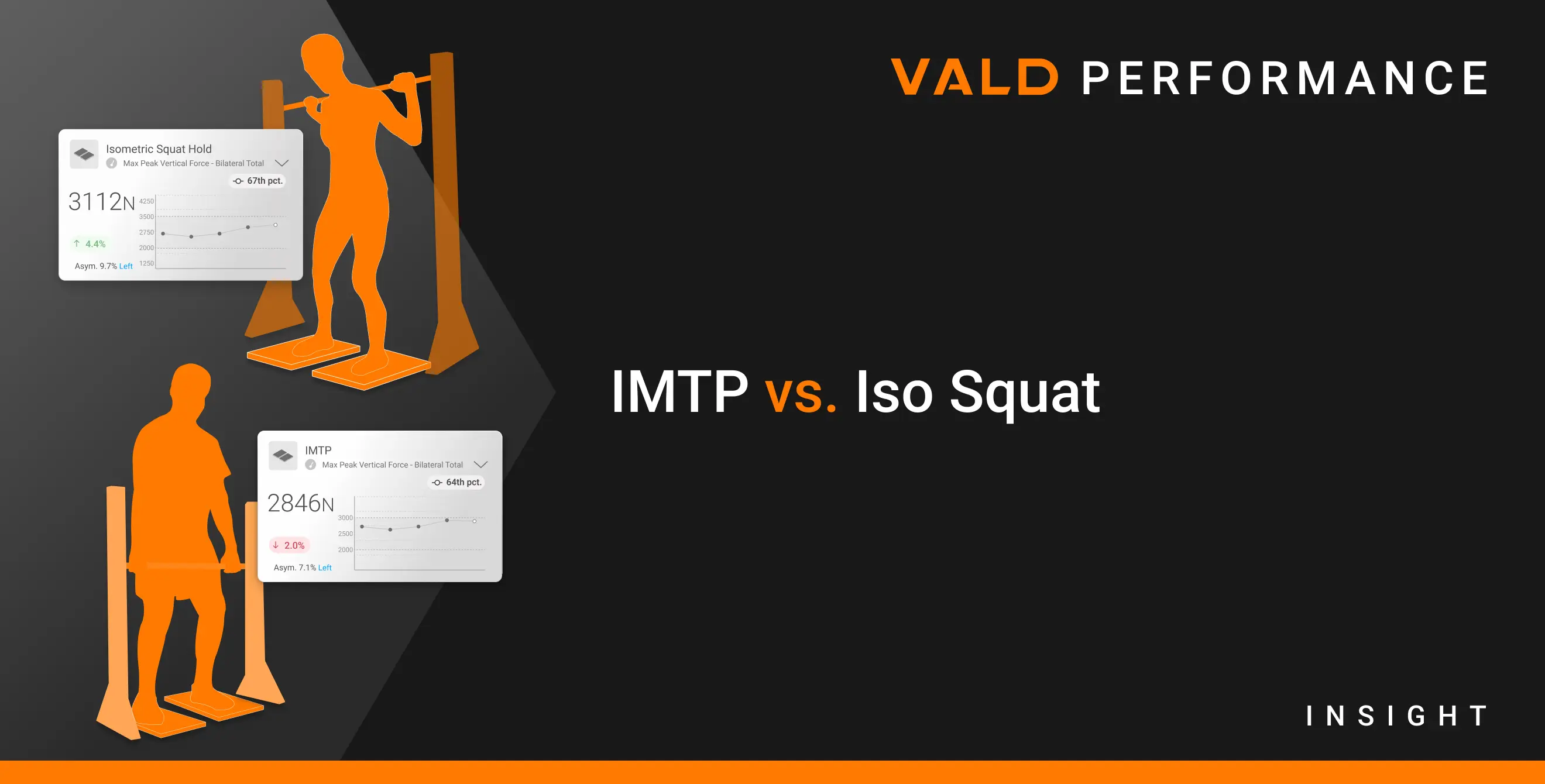
Isometric strength testing is a key tool in performance assessment, offering insights into an athlete’s ability to produce maximal and rapid force in static positions. Metrics such as peak force and rate of force development (RFD) help coaches identify performance capacities and potential deficiencies across elite athletes and general population clients.
Two of the most widely used isometric assessments – the isometric mid-thigh pull (IMTP) and isometric squat (Iso Squat) – provide distinct but complementary views of compound (multi-joint) isometric strength. This article outlines their roles, important differences and how their results guide training decisions.
Why Should We Measure Compound Isometrics?
With a large uptick in the popularity of isometric assessments, evidence consistently points to isometrics and their measurable performance qualities as reliable and effective means of athlete measurement (Grgic et al., 2022; Drake et al., 2017).
…[isometrics are] reliable and effective means of athlete measurement…
By providing metrics that give key insights into athlete performance, the IMTP and Iso Squat offer a safer, simpler and more time-efficient alternative to traditional one-repetition maximum (1RM) testing.
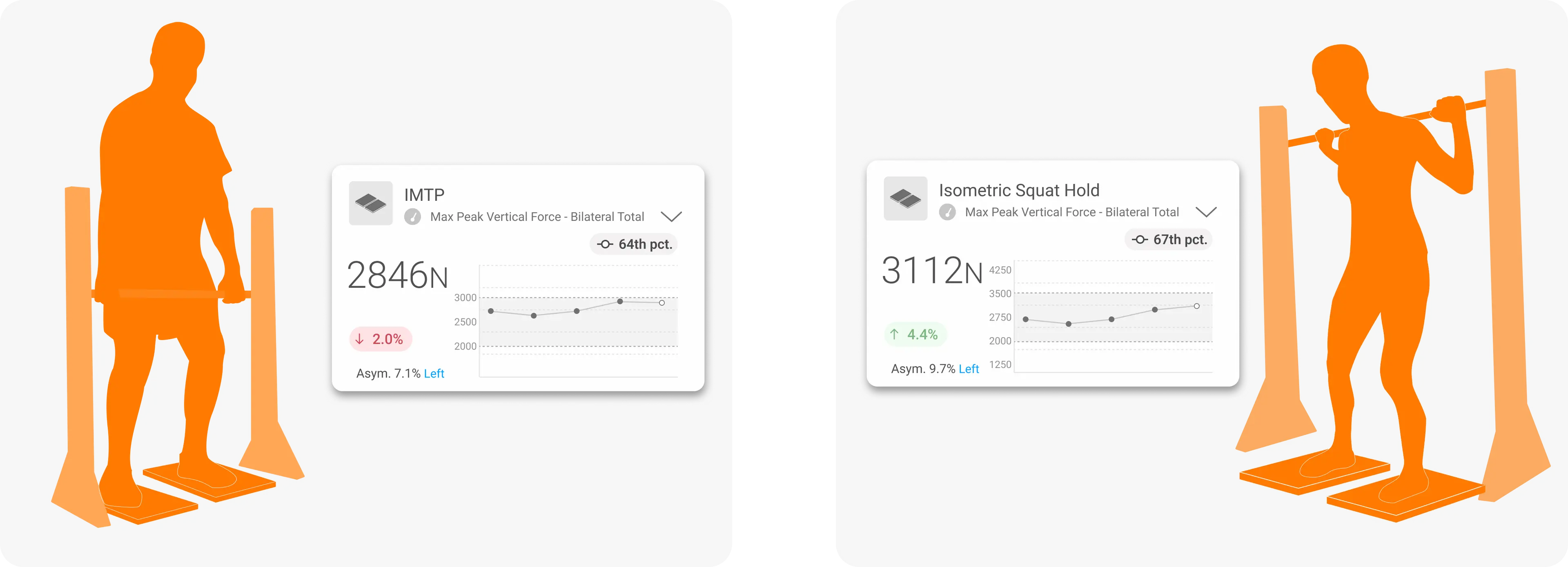
IMTP (left) and Iso Squat (right) with objective results on test performance.
With advanced technology (e.g., ForceDecks), compound isometric tests also allow practitioners to detect changes with greater sensitivity and accuracy than traditional assessments.
When working in elite sport, many practitioners know that subtle changes or increases in load can be the difference between season-ending injury and high-performance success. Isometric testing on force plates measures changes in output as low as a single Newton (N) of force, keeping practitioners informed when changes may be looming.
When combined with cloud-based data analysis platforms such as VALD Hub, practitioners can dive deeper to assess test consistency through the coefficient of variation (CoV). Low CoVs show that the athlete is consistent in their test performance, while high CoVs demonstrate greater variability in assessment outcomes.
Using CoV can help practitioners identify unreliable test efforts and monitor neuromuscular consistency over time to optimize performance or rehabilitation progress.

Athlete IMTP data showing consistent force production from test to test, represented by a low CoV.
Understanding the IMTP
The IMTP is a compound isometric test used to assess an athlete’s overall strength and force production. Isometric actions often permit greater force expression than some dynamic tasks. Therefore, the IMTP has become a popular method of assessment for academic and applied practitioners interested in maximum strength.
During the test, the athlete pulls against a fixed bar with maximal effort for 3-5 seconds, often standing on force plates (though new high-load dynamometers, such as DynaMo Max, are also capable of measuring IMTPs). When performed with objective measurement technology, the IMTP provides key performance metrics such as peak force, relative force (force / bodyweight), RFD and time to peak force.
…IMTP provides key performance metrics such as peak force, relative force (force / bodyweight), RFD and time to peak force.
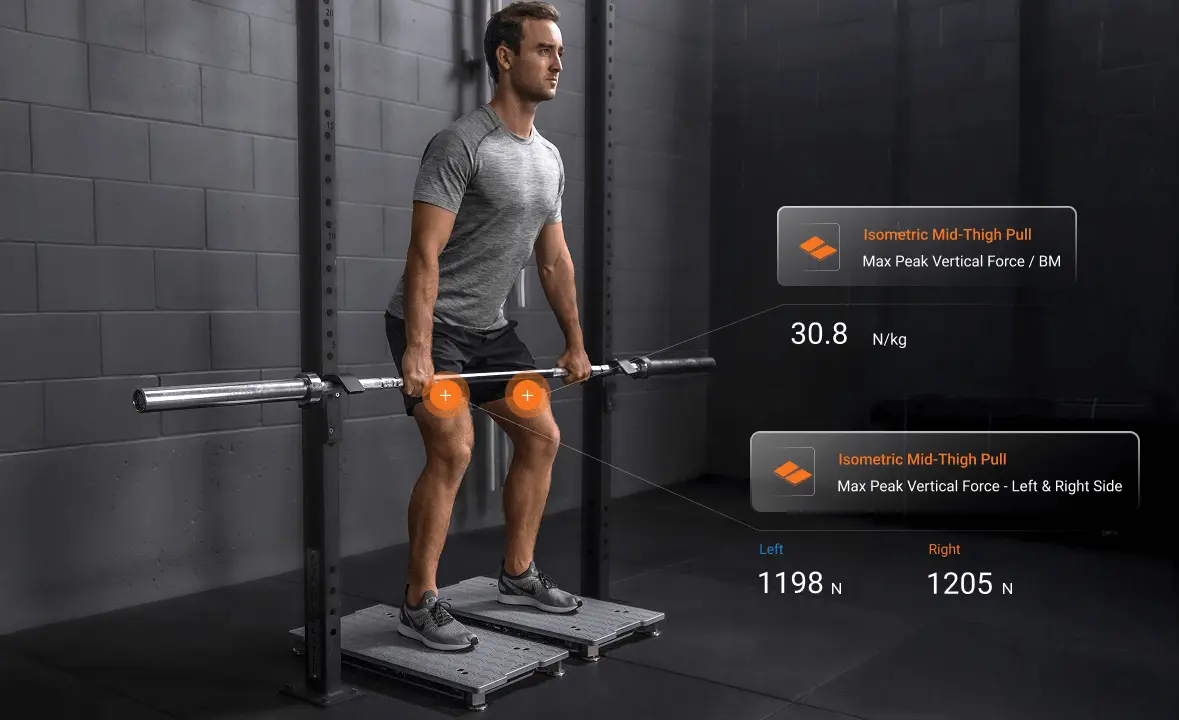
Athlete performing an IMTP on ForceDecks with specific performance measures.
IMTP Testing Guidelines
The following outlines key considerations for consistent and repeatable IMTP testing:
Positioning
- A vertical torso position should be adopted, with feet approximately hip-width apart in a comfortable stance.
- Hands should grip the bar shoulder-width apart; straps or tape are recommended to secure the hands to the bar and eliminate grip limitations.
- Hip and knee angles should be set around 135° (approximately 45° of flexion from neutral), allowing for some variation based on limb length.
- Joint positioning should be kept consistent for tracking longitudinal change – use of photos or video can assist with standardization.
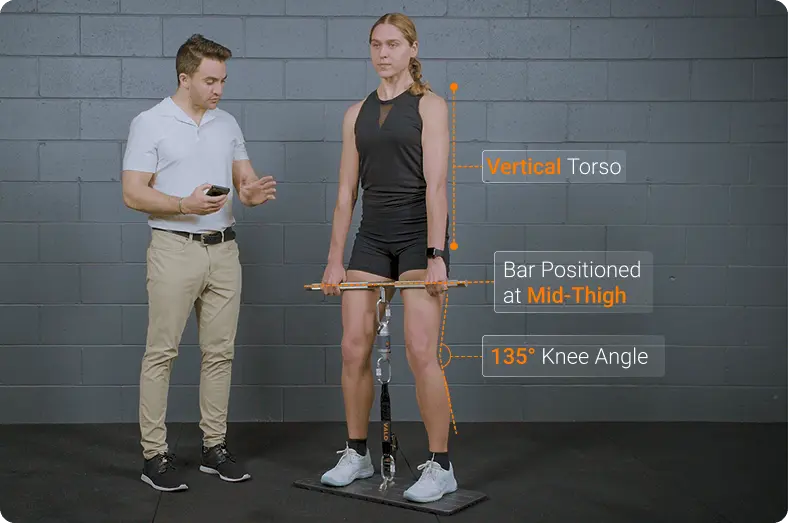
Athlete performing an IMTP with DynaMo Max, with key points of performance listed.
Cueing
Practitioner terminology may vary – some prefer to cue a “pull,” others a “push.” Although “pull” is more commonly used, it may unintentionally shift focus to an upper body-dominant execution strategy (i.e., pulling excessively with the arms). Testing both cueing options against a performance outcome (e.g., peak force or RFD) can help determine what yields the best outputs for a given population.
Although “pull” is more commonly used, it may unintentionally shift focus to…pulling excessively with the arms…
As with most isometric tests, instructing athletes to produce force “as hard and fast as possible” remains critical for valid assessment of both maximal and rapid force capacities. Most IMTP assessments last 3-5 seconds to ensure peak force is achieved.
Execution
Similar to the Iso Squat and all isometric assessments, generating pretension in the testing system is critical for high-fidelity measurement of qualities such as RFD and time to peak force.
For both the IMTP and Iso Squat, consistent pretension is key for time-constrained metrics, such as RFD. Cueing athletes to “apply the minimum force needed to remove slack” helps to ensure that athletes are not using excessive force for pretension, ultimately influencing testing results. The pretension period should show a stable, but slightly elevated force trace from baseline for at least 1 second before executing the test.
Ensure maximal effort is given for each repetition. Some athletes may adopt an “extension” strategy, where the hips push forward excessively, increasing lordosis and excessive posterior lean of the trunk and upper body. If this strategy occurs, instruct the athlete to push vertically into the ground, trying to become as “tall” as possible.
Understanding the Iso Squat
The Iso Squat is a compound isometric test used to evaluate lower-body strength and force production in a static squat position (Bazyler et al., 2015). Because the test removes the influence of movement skill, it provides a clear snapshot of an athlete’s raw force-generating capacity – particularly relevant for return-to-play and strength diagnostics.
During the test, the athlete pushes upward against an immovable bar while maintaining a fixed squat position, typically for 3-5 seconds. The test is usually performed on force plates, which capture key metrics including peak force, relative force, RFD and impulse. Joint angle standardization is essential, as different squat depths can significantly affect output and influence interpretation.
Joint angle standardization [in the Iso Squat] is essential, as different squat depths can significantly affect output and influence interpretation.
Iso Squat Testing Guidelines
The following outlines key considerations for consistent and repeatable Iso Squat testing:
Positioning
- A slightly forward-leaning torso position should be adopted, with feet shoulder-width apart and evenly balanced.
- The bar should be placed across the upper back in a high-bar (bar placed on top of the upper trapezius) or mid-bar (bar placed in the middle of the upper trapezius) position, depending on comfort and standardization.
- Hips and knees should be positioned at approximately 60° of flexion (although 90° is also valid), with some variation allotted (+/-10°) based on anthropometrics (Bazyler et al., 2015).
- A goniometer, photos or real-time video feedback can be used to assist in ensuring consistent joint angles between sessions.
- The height of the J-hooks should be recorded when a barbell and squat rack are used for the Iso Squat to ensure consistency between tests.
Athlete executing an Iso Squat with key points of performance listed.
Cueing
Cueing should emphasize intent and leg drive. Instruct athletes to “push into the ground as hard and fast as possible” to capture maximal and rapid force-generating capacities. Avoid cues that reference lifting or rising under the bar, which may introduce unwanted movement.
Instruct athletes to “push into the ground as hard and fast as possible” to capture maximal and rapid force-generating capacities.
Execution
Athletes may shift and change their joint angles during the assessment. If this occurs, instruct the athlete to maintain the same position throughout the entire test.
Just like any dynamic assessment, performing the IMTP and Iso Squat requires a sufficient warm-up period and practice. Performing 2-3 warm-up efforts that slowly build in intensity (e.g., 50%, 75% and 90% effort) helps familiarize the athlete with the test and allows for optimal test performance.
Similarly, it is important that athletes generate a small amount of pretension before initiating the test (e.g., 10% of peak force, cued as 10% effort). This helps produce more accurate and repeatable measurements – especially for time-constrained metrics such as RFD and force at specific time points (e.g., 100ms).
[Pretension] helps produce more accurate and repeatable force-time measurements – especially for metrics such as RFD and force at specific time points.
Similarly, creating pretension prior to test execution enhances safety and comfort with test execution, limiting sharp and aggressive impacts between the subjects’ upper back and the bar.
Key Differences Between IMTP and Iso Squat
While both the IMTP and Iso Squat provide valuable insights into lower-body force production, they differ in setup and performance characteristics – both of which may influence test selection.
Commonly, athletes will produce greater forces during the Iso Squat (up to 1.4 times greater in elite track athletes) and may have greater differences in force for females (Stavridis et al., 2021; Brady et al., 2018).
The IMTP is modeled after the second pull of an Olympic lift and requires strict bar placement and trunk positioning. This makes it highly standardized but limits testing customization. Adjusting joint angles is difficult without altering the nature of the test. The Iso Squat, while involving similar joint positions, allows for easier modification of squat depth and stance, making it more practical for assessing force production across multiple positions (e.g., thighs-parallel position vs. 60° knee angle).
The setup is relatively straightforward for both tests, but each presents unique considerations. In the IMTP, grip strength can become a limiting factor without the use of lifting straps or external fixation, potentially reducing maximal force output. The Iso Squat removes this issue but can introduce the challenge of upper back discomfort, which can also impact force expression. Subject preference, comfort and equipment access should guide the decision between tests.
Subject preference, comfort and equipment access should guide the decision between [selecting the IMTP or Iso Squat].
From a data perspective, both assessments provide comparable metrics when using technologies such as ForceDecks or DynaMo Max. However, the IMTP is more widely researched, offering greater access to normative values and validated benchmarks. The Iso Squat, while effective, has less published data, which may limit its utility for practitioners seeking established reference standards.
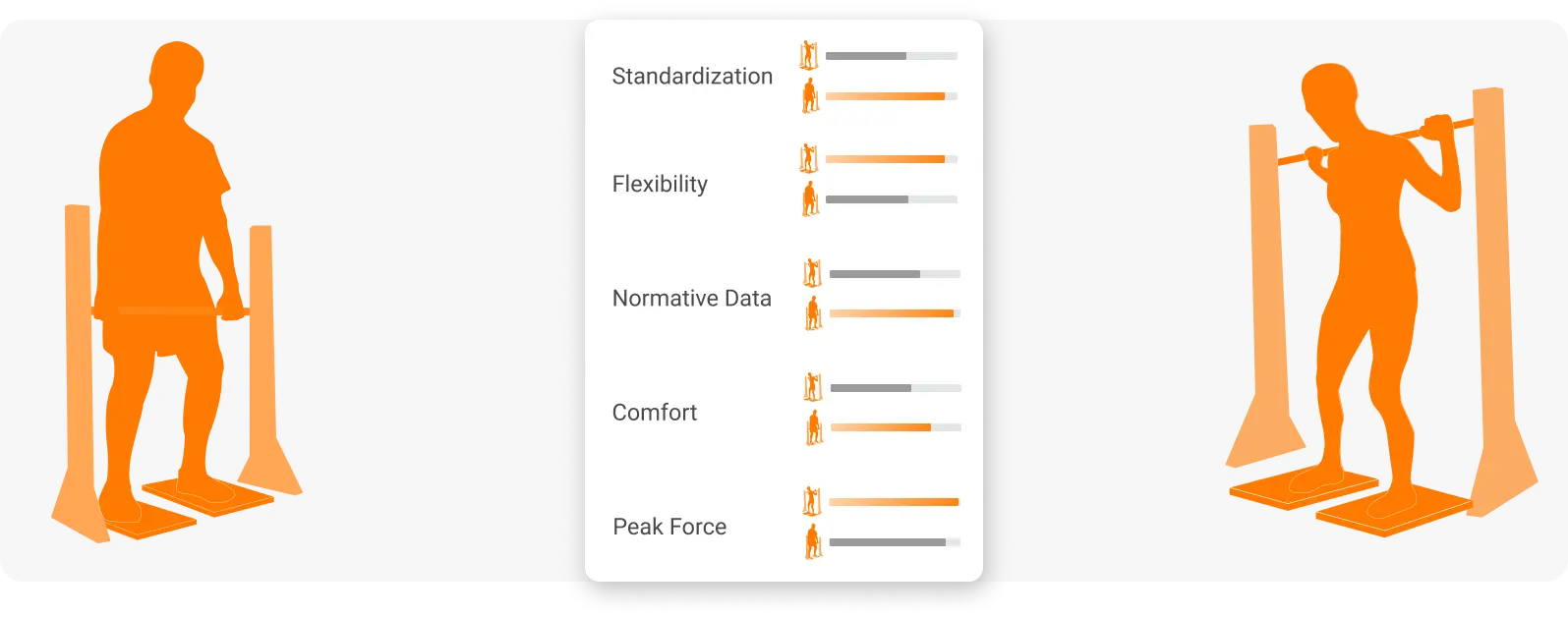
Comparison of specific characteristics that benefit the IMTP and Iso Squat independently.
Practical Considerations
As mentioned previously, standardization is key. However, this extends beyond test setup considerations and includes how practitioners approach their data analysis. By addressing changes to data and athlete outputs with the same systematic approach, practitioners can simply and consistently make sense of the data they collect.
General analysis recommendations for data analysis include:
- Metric Selection: Creating a tiered list of metrics allows practitioners to focus on the most important aspects of the IMTP or Iso Squat first. As a test of maximal force production, peak force is often a practitioner’s typical “first-tier” metric.
- Force-Time Curve Assessment: Assessing each force-time curve in software such as ForceDecks’ iOS app immediately before uploading allows practitioners to look out for any unwanted execution strategies (e.g., lack of pretension before start of movement) that may affect data quality.
- Integration with Performance Metrics: Using IMTP or Iso Squat alongside other data sources provides higher-quality data that paints a larger picture when assessing performance status, readiness and charting rehabilitation progressions.
Force-time trace of an athlete performing an IMTP, with key metrics and phases labeled.
Timing is also a critical part of standardization. Testing should occur at the same point in the workout every time to ensure consistent, comparable data. Ideally, tests are performed after a thorough warm-up but before fatigue sets in from training. Testing too early can lead to underperformance, while testing too late can skew results from fatigue. Consistent timing improves reliability and makes it easier to track meaningful progress over time.
Consistent timing improves reliability and makes it easier to track meaningful progress over time.
Which Test Is More Appropriate?
When deciding between isometric tests such as the IMTP and the Iso Squat, both kinetic (force output) and kinematic (movement pattern) relevance should be considered. Different athlete backgrounds can guide which test is more appropriate.
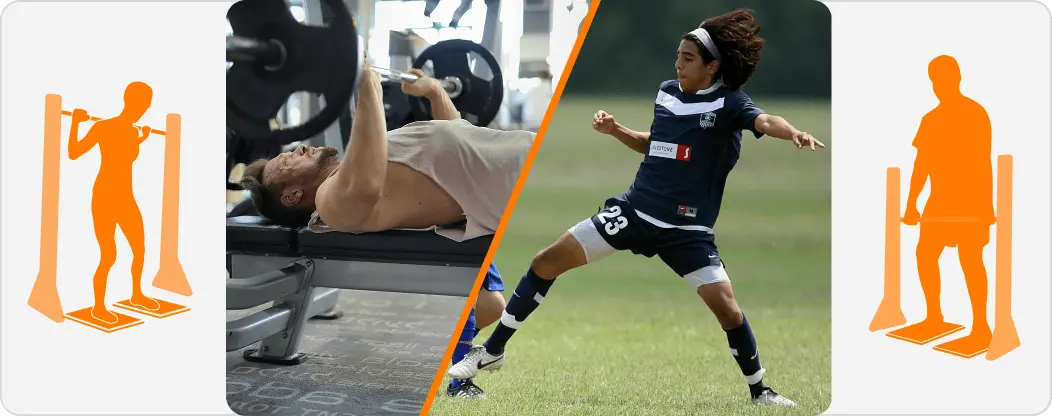
Two athletes with different qualities that make them a better fit for either the Iso Squat or IMTP.
Case 1: Jordan’s First Testing Session
Jordan is a soccer player with minimal resistance training experience. While explosive on the field, he has limited exposure to barbell lifts such as the squat or bench press. After testing both assessments, Jordan performed better on the IMTP due to greater comfort and simplicity in execution.
Moving forward, Jordan and his coach have agreed to monitor strength improvement via the IMTP. As his comfort and familiarity with barbell training improve, they will periodically trial IMTPs to gauge his execution ability, allowing for alternate testing options as needed.
Case 2: Chris’ Meet Prep Assessment
Chris is a competitive powerlifter who has trained barbell movements for over a decade. Currently, he is experiencing problems with his lockout position in the squat, hitting a “sticking point” around 70° of knee flexion.
His comfort with barbell lifts and current training struggles makes the Iso Squat a feasible and ecologically valid assessment. By integrating Iso Squat assessments into Chris’ powerlifting meet prep, his performance coach can monitor his maximal and rapid force-generating qualities near lockout to better optimize his performance.
In both cases, athlete background, sport demands and movement familiarity guide the test selection. For rehabilitation or fatigue monitoring scenarios, comfort and movement tolerance should always come first. If an athlete struggles or experiences discomfort with one test, the other can be easily substituted without losing the value of objective force tracking.
Applications and Context
No single test between the IMTP and Iso Squat is superior – both have specific applications contingent upon sport and what the practitioner is looking to get out of the test.
Ultimately, choosing the right test depends on the sport, the athlete’s needs and the testing environment or logistical constraints.

Comparison and contrast between the IMTP and Iso Squat based on their specific benefits.
Practitioners looking to implement one or both tests should also consider both the kinematic and kinetic correspondence. This ensures the test has the highest potential to deliver data most relevant to the movement, output or physical characteristics demanded by a given sport. When the sport and the test are a match from a transference perspective, data will be most insightful.
Both IMTP and Iso Squat can provide valuable insights into force production, strength development and readiness monitoring.
To learn more about isometric testing and how objective measurement technology can improve your practice, contact VALD to schedule a consultation.
References
- Grgic, J., Scapec, B., Mikulic, P., & Pedisic, Z. (2022). Test-retest reliability of isometric mid-thigh pull maximum strength assessment: a systematic review. Biology of sport, 39(2), 407–414. https://doi.org/10.5114/biolsport.2022.106149
- Drake, D., Kennedy, R., & Wallace, E. (2018). Familiarization, validity and smallest detectable difference of the isometric squat test in evaluating maximal strength. Journal of Sports Sciences, 36(18), 2087–2095. https://doi.org/10.1080/02640414.2018.1436857
- Bazyler, C.D., Beckham, G. K., & Kimitake, S. (2015). The use of the isometric squat as a measure of strength and explosiveness. The Journal of Strength & Conditioning Research, 29(5): 1386–1392. https://doi.org/10.1519/jsc.0000000000000751
- Stavridis, I., Fragkoulis, E., Tsopanidou, A., Economou, T., Tsolakis, C., Koulouvaris, P., & Paradisis, G. (2021). Differences in maximal strength capacity between isometric squat and mid-thigh pull tests in elite track and field athletes. ISBS Proceedings Archive, 39(1), 340. https://commons.nmu.edu/isbs/vol39/iss1/87/
- Brady, C. J., Harrison, A. J., Flanagan, E. P., Haff, G. G., & Comyns, T. M. (2018). A Comparison of the Isometric Midthigh Pull and Isometric Squat: Intraday Reliability, Usefulness, and the Magnitude of Difference Between Tests. International Journal of Sports Physiology and Performance, 13(7), 844–852. https://doi.org/10.1123/ijspp.2017-0480
